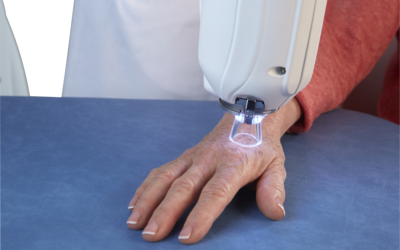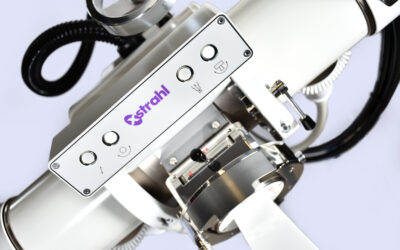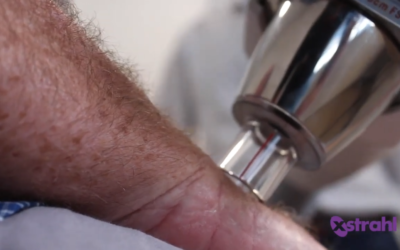
Non-melanoma skin cancers (NMSC) are the most commonly diagnosed cancers in the world. Despite their relatively low malignant potential and mortality rate, NMSC are associated with a high morbidity and substantial treatment cost, and they significantly affect patient quality of life. In addition, there is an increase in NMSC incidence worldwide due to environmental factors and increased UV radiation through climate change. Given the fact that most NMSCs are observed in the elderly population there is a need for a safe, pain free, non-invasive treatment, which has a low impact on life. The Xstrahl 100 system, used by Léonard de Vinci Centre in France, is ideally suited for the treatment of superficial skin cancers, such as basal cell and squamous cell carcinomas. This x-ray therapy device is demonstrating impressive positive results.
Centre Léonard de Vinci & Dr Franck Darloy
The Léonard de Vinci Centre is an integral part of the Medical Centre of Pont Saint Vaast (Douai). Specializing in diagnostic imaging and oncology, the group is made up of eminent practitioners and specialists in chemotherapy, radiotherapy and radiology experts from across France.
Dr Franck Dalroy has more than thirty years’ experience in radiation oncology, twenty five of which he has worked at the Léonard de Vinci centre. He is a member of the multi-disciplinary team, which consists of surgeons, dermatologists, oncologists who make decisions on the best methods of treatment. By attending monthly team meetings, Dr Darloy has dramatically increased referrals for the Xstrahl 100 system.
Since the Xstrahl 100 was installed at the centre in 2012 the number of patients treated has increased from 50 per year (treated on a linear accelerator) to an average of 136 per year from 2012-2016 (on the Xstrahl 100). To date, they have treated over 650 patients.
Non-melanoma Skin Cancers
The first choice of treatment for many practitioners of non-melanoma skin cancer is surgery. However, this invasive method of treatment is not always suitable due to scarring, a major concern if lesions are located on the face and neck or for elderly people who might suffer from concurrent or pre-existing conditions.
Superficial therapy has been used for NMSC treatment since 1990 and has demonstrated great cure rates (95%) and excellent cosmetic results. This is the method of choice in the case of large lesions, tumours in particular localisations, difficult to reach areas, or the inability to attempt a surgical excision for medical reasons, as well as elderly patients.
“It is an excellent alternative to surgery with outstanding clinical results, contact therapy is particularly suited to elderly patients. The rates of cures, in our experience, are excellent with good aesthetic results”.
Dr Franck Darloy
Treatment
Léonard de Vinci Centre offers the radiotherapy option to treat basal cell and squamous cell carcinomas. The treatment decision is made in a multidisciplinary meeting where surgeons, dermatologists, radiation therapists and oncologists discuss the various treatment options.
Their technique uses low energy X-rays (50 kV), meaning that the dose does not go deeper than the surface of skin, so normal tissue and organs at risk remain healthy. Each treatment is simple, lasts only one or two minutes, and the patient can be treated seated. No local anaesthesia is required as the treatment is absolutely pain free. The treatment applicator is applied directly to the treatment area.
A typical dose and fractionation regime are used of 45Gy in 10 or 15 fractions delivered 3 times per week.
Xstrahl 100
Pinpoint accuracy makes the Xstrahl 100 the perfect choice for superficial treatments. It is ideal for treating a wide range of superficial skin cancers, such as basal cell or squamous cell carcinomas, as well as benign dermatological conditions such as keloid scars.
The range of Xstrahl 100 treatment arm movement enables smooth adjustment and easy set up for each treatment field. Its flexibility makes it particularly suited for treating lesions that are difficult to access, such as the head and neck; and without compromising patient comfort.
Conclusion
The requirement for superficial radiotherapy treatment is increasing due to the rising incidence of non-melanoma skin cancer all over the world and an increasing number of patients who opt for this non-surgical alternative because of its effectiveness, high cure rate and excellent cosmetic result.






